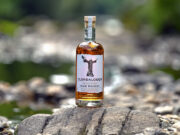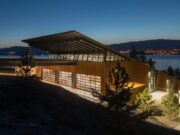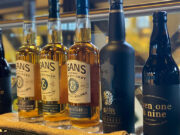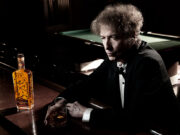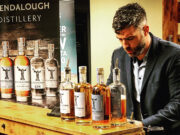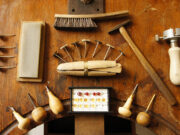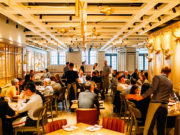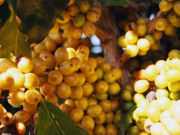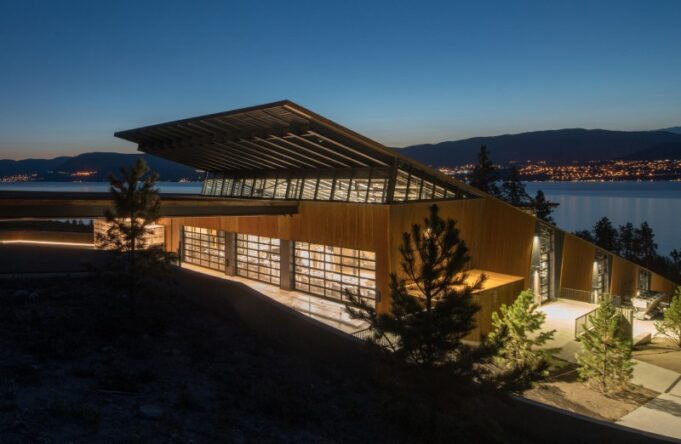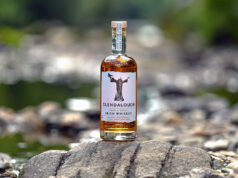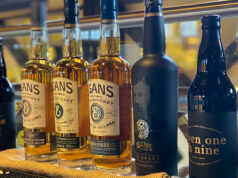Shane Munn and Martin’s Lane Winery
Tasting wines with Shane Munn is always a relaxed, fairly modest affair, except for the steep knowledge he imparts, every time out. That, and the extraordinary wines he makes, and he genially pours. Over several years now Munn and the wines he makes at Martin’s Lane, three versions of Riesling, four versions of Pinot Noir, all extremely low productions of extremely low yields, have evolved very nicely, if not always in predictable ways. For high quality wines produced in British Columbia, Martin’s Lane is a bit of a marker, a clear signal that potential is one thing, the beginnings of achievement another. These days, BC wine is not only striving, though it continues to do that every year. It is time to acknowledge a new era in BC wine. The era of arrival.
The winery was designed with geography and ecology front of mind, by renowned architect Tom Kundig, who did the now- iconic Mission Hill winery, one of Architectural Digest’s three most beautiful wineries in the world. Kundig also did Checkmate winery, near Oliver, BC, further south in the Okanagan. All three are part of von Mandl Family Estates, owned by a visionary by any reckoning, Anthony von Mandl. Cedar Creek Estates is part of the family, and Martin’s Lane is tucked into the hillside just adjacent to and above Cedar Creek. It is here that Munn practices his wizardry every day, meticulously guiding the vines, coddling the juice when it arrives and works its way through the completely gravity-fed winery until it resting place in the cellars far below the crush pad. “It’s efficient, practical, and very gentle on the fruit,” Munn says, in his almost but not quite off-handed way.
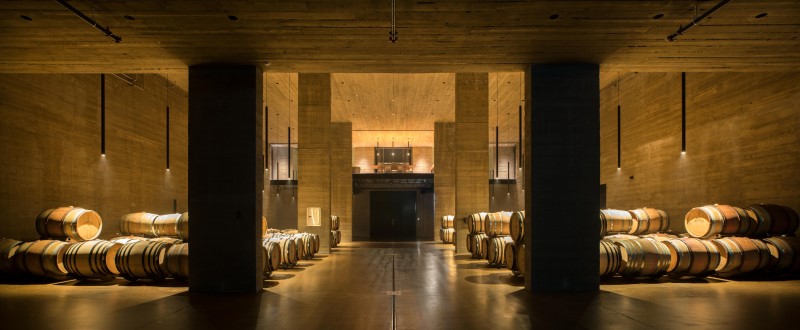
The industrial part of the winery is beautiful in its own way, and the cathedral-like barrel room seems to encourage any visitor to speak in hushed tones. The other parts of the winery, both exterior and interior, are laced with thoughtful touches, an homage here, there, everywhere, to the history and terroir of this precise place. A lovely reception area, at the top of a large, winding staircase, leads into a tasting room with expansive views of the entire North Okanagan, and you can discern, on a clear day, the bell tower at Mission Hill far across the lake. Adjacent to the tasting room is another, workaday tasting room, which Shane clearly enjoys working in, with its temperature-controlled storage, deep-well spitting and rinsing sinks for each of the four stations, and, again, the expansive views, Cedar Creek winery bustling with activity just below.
It is here that Munn practices his wizardry every day, meticulously guiding the vines, coddling the juice when it arrives and works its way through the completely gravity-fed winery until it resting place in the cellars far below the crush pad.
Martin’s Lane rarely, if ever, bustles. It is open by invitation or appointment only, an innovative wrinkle in the von Mandl master plan to underscore high quality levels that are not just possible but are reality, in the Okanagan. In a private dining room on the entry level (the entry itself discreet, almost invisible save for a tiny doorbell attached to one of the outer walls), two wine walls reside, containing such treasures as J.J. Prum Riesling Ausleses and Beereneausleses, Domaine Weinbach Vendage Tardive Riesling, and Domaine Romani-Conti in various vintages and bottlings. Shane always smiles when he walks into this room. “It’s quite a display, isn’t it? The important thing is not that our own quality rises to this level, but rather that our own wines are also unique, and speak eloquently to the place of origin.” It’s an interesting idea, for sure. Martin’s Lane is about high-level quality, assuredly. But not in a comparative way, as in a competition. “It is all about specificity,” says Munn. “These wines on the wall are really an inspiration. Some of our Pinots might remind people of high-altitude single vineyard Sonoma, or even Burgundy itself. But they are not copies, not emulations. They are of their own terroir, and therefore completely unique.”
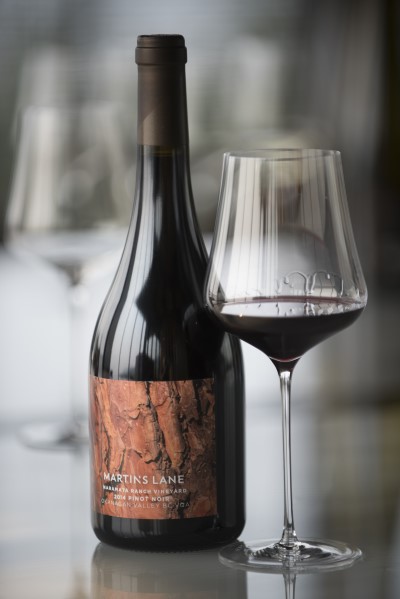
The program is to nurture and develop all this, to find what Shane calls “unexpected sources of greatness. Our Naramata Ranch Pinot has shown the most evolving style thus far. And the 2017 Fritzi’s Riesling I could happily show internationally.” This project is all about evolution of sites and evolution, therefore, of fruit. Production levels are tiny. Sometimes below 200 cases for a particular site. But it is all about getting the most from what the soil, the climate generally and vintage by vintage, in conjunction with the vines, will actually proffer.
The wines, all hand selected, hand picked, all single rows within single vineyards. All are from von Mandl Family Estates vineyards, and Shane works with other winemakers within the group to figure out the best fruit for the best purpose. But Shane kind of picks first. The wines are: Riesling; Fritzi’s; Naramata Bench; Simes Vineyard. Pinot Noir:
Naramata Ranch; De Hart; Simes; Fritzi’s. Well to take note of the Simes echo, since John Simes was the intrepid winemaker who helped put Anthony von Mandl on the map, saw the same potential as his boss, and made incredible strides for viticulture and winemaking for the entire valley. Fritzi happened to be von Mandl’s mother. Martin, his father. The Naramata property is high on a hilltop, so reminiscent of mountaintop Sonoma by Peter Michael or Flowers. DeHart is a select Simes project years in the making. And it is all coming round the mountain, so to speak.
And yes, it is a gospel of sorts, of the region’s potential, of what it has done, what it is doing, and what it will evolve into. Shane Munn, in the midst of it all, is the epitome of calm: “we have these lovely vineyards, and more coming into maturity. We observe the evolution of vineyards, and if we are wise enough, we can adapt, take what the vines give us, and make the best wines possible. And those wines are, in my opinion, worthy of any table.”
Shane Munn, in the midst of it all, is the epitome of calm: “we have these lovely vineyards, and more coming into maturity. We observe the evolution of vineyards, and if we are wise enough, we can adapt, take what the vines give us, and make the best wines possible. And those wines are, in my opinion, worthy of any table.”
The only way to know what these wines are, is of course to taste them. Don’t take my, or anyone else’s word for it. But what I can say, as I work through my extensive tasting notes for several of these wine over several vintages: there is a common thread. The Rieslings show racy acidity, and amazing heft, to create a wonderful balance. Some wetness, yes, and Shane can happily recite the levels, but invariably these wines are balanced and lovely. Deep and rich. Yet light, amazingly so, on their feet. You can easily conjure up late harvest German Rieslings, or Alsace. But all three, quite distinct for each other in terms of fruit profile, acidity and sweetness, are wine of fantastic aplomb.
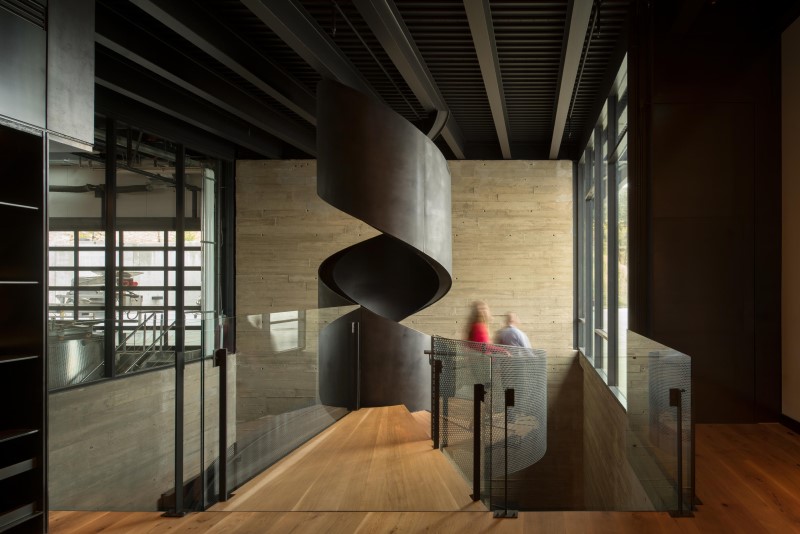
The Pinot Noirs, well, much the same applies, they are so well made. Soft, supple, deep and rich fruits, beautiful acidity, great body. All lush as hell. But, singularities in terms of fruit typicity, of earthen notes, so some are reminiscent in the least, of ultra-rich Sonoma, others of earthen, barnyard and sundried plum, of the classic Burgundies. We are speaking in very general terms, here, of wines that deserve you attention, bottle by bottle. Shane Munn has, of course, the last word. “We are rewarded each year, by the unexpected sources of greatness in these vineyards. We just guide them home.” Welcome to the age of arrival.



